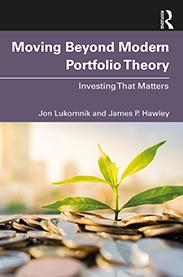(Note: Jon Lukomnik is a senior fellow of High Meadows Institute. This article is the second of three blogs adapted from their new book, Moving Beyond Modern Portfolio Theory: Investing That Matters, to be published in April.)
Finance is, or normatively should be, a service function. For example, asset management provides investors with a desirable risk/return profile for their investments and allocates capital (intermediation) where it is needed by society and the real economy.
Contrary to popular memes about greed, making money is not asset management’s purpose. We concede making money is necessary, much like breathing is required for living. That said, few would consider breathing as the purpose of life. We should not confuse an essential input into self-perpetuation with asset management’s broader socio-economic purpose.
Optimizing risk and return is the heart of today’s investment management industry. No matter the strategy – active, passive, quantitative, factor-based, fundamental, or something else – the goal is still return per unit of risk. While that framing is necessary for asset management to fulfill its purpose, it is also entirely insufficient. Risk /return management needs to be multi-temporal as well as multi-dimensional. That means it should concern itself both with the financial return to the investor per unit of risk today and with the intermediation interrelationship, since that will affect the conditions of life in which the financial return will be expended. Looked at through an inter-temporal lens, decisions that seem to make sense today can result in an untenable tomorrow. Or a more beneficial one.
Yet, today, the risk/return optimization function is disconnected from “conditions of life,” or the broader context in which future income flows (the desired output of investing) are expected. For example, a retirement pension will be spent in the context of the conditions in which that individual lives during his or her retirement years. From a conditions of life point of view, if climate change or pollution negatively impacts the health and welfare (or asset values, e.g., home ownership) of the individual, even an extremely good financial return likely will not buy the conditions of life that may have existed when savings and investment began. Or if social unrest created by increased levels of income inequality force one to live in a gated community surrounded by security guards and electrified fences like some dystopian science fiction movie (or to live outside such a community looking in), the financial return may not be adequate compensation for the inability to live in a socially cohesive environment. In other words, it is not that incremental greenhouse gas emissions will degrade or improve an investor’s returns today, but that the financial return earned today will likely be spent in a different time period, in different conditions, caused, or at least affected by, the intermediation impact of investors’ capital today.
Even without considering extended risk over time, the risk mitigation/return generation ability of asset management is neither simple to understand nor to execute. Risk is multi-dimensional and minimizing one risk can increase another. For example, permanent loss of capital is among many people’s worst fears. One can easily mitigate that risk by keeping investments in cash, but that subjects one to inflation risk. Such an action also affects intermediation, since cash is usually tied to a bank or bank-like institutions, meaning that the capital available through intermediation when investors undertake such risk avoidance behavior most often will be in the form of a loan, not equity. The relationship between investors seeking an appropriate level of risk and return, and the amount and form of capital available for intermediation, is ever present.
As with risk mitigation, the horizons of intermediation need to be extended. Extended intermediation includes expanding one’s view of the use of capital both temporally and horizontally: the extended view includes intermediation’s effect on systems, over time.
Today’s state of intermediation – with tens of agents standing between savers and their investments – can alienate savers from their rights and responsibilities as providers of capital. Considering extended intermediation is a way to minimize that alienation. A critical component of extended intermediation analysis is how asset management accounts for (or too typically, does not account for) the costs (or benefits) of economic externalities. Concretely, this suggests an additional focus on the efficient allocation of capital for the economy and society as well as for the individual user of the capital. Such societal costs/benefits can be either pecuniary or non-pecuniary, the former having a clear monetary impact (the cost of making polluted water cleaner) or non-pecuniary (the loss of enjoyment of a riverine landscape). If asset owners and managers ignore the externality effects of their investments, the intermediation process will likely be less than optimal, as negative externalities feedback from the real economy/society to the capital markets. Traditional notions of intermediation do not capture this idea because their frame of reference is entirely within financial markets and the time horizon is, if not immediate, short-term. Both sets of blinders prevent an investor from understanding the impact of his/her investment on the future states of society, the economy and the capital markets themselves, which, in turn will drive most of that investor’s return.
If we are to truly judge how well asset management meets its twin goals of 1) a desirable risk/return to an investment and 2) societally positive intermediation, then we have to move beyond current asset management practice to extended risk and extended intermediation.
Jon Lukomnik and James P. Hawley’s book, Moving Beyond Modern Portfolio Theory: Investing That Matters, is now available for pre-order here.

